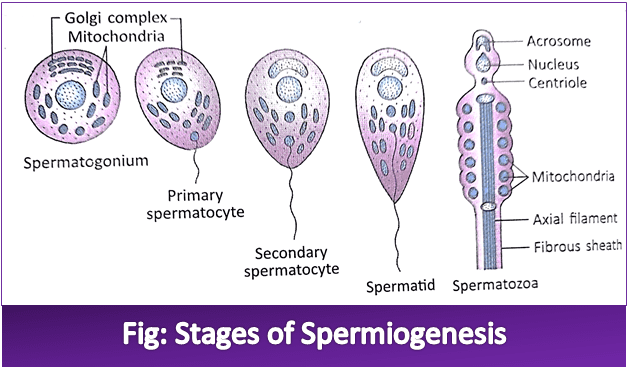Spermatogenesis:
Spermatogenesis is the process in which spermatozoa are produced from male primordial germ cells by mitosis and meiosis. The initial cells in this pathway are called spermatogonia, which yield primary spermatocytes by mitosis. The primary spermatocytes are further divided by meiotic division to form secondary spermatocytes. Each secondary spermatocyte divides mitotically to give rise to two spermatids. These spermatids don’t divide further but undergo morphological changes to form spermatozoa.
Stages of Spermatogenesis:
1. Formation of Spermatids: Spermatogonia are considered primitive or primordial germ cells that serve as a pool of undifferentiated stem cells from which spermatozoa develop. There are two types of spermatogonia can be found –

Type A Spermatogonia: It serves as the stem cells.
Type B Spermatogonia: It is considered precursor of sperms.
Phase I: Each Type B Spermatogonium divides mitotically 5 times to give rise to 32 Type B Spermatogonia.
Phase II: In this phase, 64 primary spermatocytes are formed from 32 Type B Spermatogonia by mitotic division.
Phase III: Now each primary spermatocyte undergoes 1st meiotic division to give rise 128 primary spermatcytes further undergo 2nd meiotic division to form 256 secondary spermatocytes.
Phase IV: Now each secondary spermatocyte divides mitotically to give rise to two spermatids. Thus from 256 secondary spermatocytes, 512 spermatids are formed.
2. Formation of Spermatozoa from Spermiogenesis: The transformation of spermatids into spermatozoa is called spermiogenesis. But it is to be noted that spermatids only undergo morphological changes to form sperms. The spermatids mature into sperms or spermatozoa in the deep folds of the cytoplasm of the Sertoli cell. The spermatozoa are later known as sperm. Various parts of spermatids take part in the formation of spermatozoan such as a nucleus, Golgi apparatus, mitochondria, cell membrane, etc.

After spermatogenesis, sperm heads become embedded in the Sertoli cells and are finally released from the seminiferous tubules by the process called spermiation. Thus a mature spermatozoon becomes free in the lumen of the seminiferous tubules.